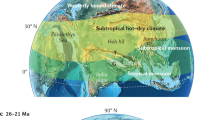Abstract
During the period from 25 to 17 Ma BP, when the second plateau uplifting, i.e. the second phase of the Himalaya movement, occurred, the Qinghai-Xizang Plateau reached an altitude high enough to chbge the situation of the general circulation. Such an effect of the plateau on the atmospheric circulation was accompanied by the warrning of the tropical ocean, the enhancement of the cross equatorial current, the enlargement of the marginal sea basins in the east-southeastern Asia, the westward extending of the Asian continent and the regression of the Paratethys Sea. As a result, the thermal difference was enlarged, and the air currents were enhanced between continents and oceans; finally the Asian monsoon system, mainly the summer monsoon, was initiated. The former planet wind system was then substituted by the monsoon system, and this caused the important environmental changes, such as the large shrinkage of the dry steppe in Central Asia, and the extension of the humid forest zone in East Asia. Thme changes have been dated at 21.8 Ma BP on the Lingxia profile in the northeastern border of the Tibet Plateau, when the savanna was transformed into the forest.
Similar content being viewed by others
References
Yin Jiexiang, Sun Xiaoxin, Sun Yiyin et al., The stratigraphical investigation of the double Mollase belt in Shigatze area, Xizang,Memoirs of Institute of Geology CAS (in Chinese), Vol. 3, Beijing: Science Press, 1988, 158–176.
Li, J. J., Fang Xiaomin, Pan Baotian et al.,Uplijt of Qinghai-Xizang (Tibert)Plateau and Global Change, Lanzhou: Lanzhou University Press, 1995, 1–83.
Zhang Linyuan, The formation process of Qinghai-Xizang plateau and stage division of Cenozoic climatic evolution in China, inAnnals on the Formation, Evolution, Environmental Changes and Ecosystems of the Qinghai-Xizang (Tibetan) Plateau (in Chinese), Beijing: Science Press, 1995, 267–280.
Zheng Mianping, Guo Zhengtang, Initiation and evolution of the Asian monsoon system finely coupled with the ice-sheet pwth and the tectonic movements in Asia,Quaternary Science, 1988, (3): 935.
Gu Zugang, Wang Sihai, Hu Xiangyang et al., Research progress on biostratigraphy of Tertiary Red Beds in Linxia Basin, inAnnals on the Formation, Evolution, Environmental Changes and Ecosystems of the Qinghai-Xizang Plateau (in Chinese), Beijing: Science Press, 1995, 91–95.
Wang Jian, Xi Ping, Liu Zecun et al., Cenozoic Climatic and topographical changes in the western Qaidam Basin,Geological Review (in Chinese), 1996, 42(2): 166.
Zhong Dalai, Ting Lin, Rising process of the Qinghai-Xizang (Tibet) Plateau and its mechanism,Science in China, Ser. D, 1996, 39(4): 369.
Harrison, T. M., Copeland, P., Kidd, W. S. F. et al., Raising Tibet,Science, 1992, 255: 1663.
Johnson, N., Stix, J., Taux, L. et al., Paleomagnetic chronology, fluvial processes and tectonic implications of the Siwalik deposits near Chinji Village,Pakistan J. Geol., 1985: 93, 27.
Harris, N., Significance of weathering Himalayan metasedimentary rocks and leucogranites for the Sr isotope evolution of sea water during early Miocene,Geology, 1995, 23(9): 259.
Chang Chengfa, Geotectonic evolution of the Qinghai-Xizang Plateau, inProceedings of the First Symposiwn on the Qznghai-Xizang Plateau (in Chinese), Beijing: Science Press, 1992, 243–255.
Zhang Penxi,The Late Cenozoic Evolution of Geologic Environments of the Qaidam Basin (in Chinese), Beijing: Science Press, 1986, 50–58.
Huang Huafang, Peng Zuolin, Lu Wei et al., Division and comparison of the Tertiary magnetic stratigraphy in Jiuxi and Jiudong Basin,Bulletin of Gansu Geology (in Chinese), 1993, 2(1): 6.
Li Jijun, Fang Xiaomin, Zhu Junjie et al., Paleomagnetic chnonology and type sequence of the Cenozoic stratigraphy of the Linxia Basin in Gansu Province of China, inAnnals on Fonation, Evolution, Environmental Changes and Ecosystems of the Qinghai-Xizang (Tibetan) Plateau (in Chinese), Beijing: Science Press, 1995, 41–54.
Dong Wenjie, Tang Maocang, A numerical modelling study on the processes of uplift and planation of the Tibetan Plateau,Science in China, Ser. D, 1997, 40(3): 246.
Tang Maocang, Lin Zhenyao, Shen Zhibao et al., Plateau rising and atmospheric circulation,Fonnatwn and Evolution of Qinghai-Xizang Plateau (in Chinese) (ed. Sun Honglie), Shanghai: Science and Technology Press, 1996, 152–194.
Tang Maocang, Liu Xiaodong, A new mark for delimitation of Quartemary: stable appearance of plateau monsoon and its environmental effects,Quarternary Sciences (in Chinese), 1995, 1: 82.
Trenberth, K. E., Chen, S. C., Planetary waves kinematically forced by Himalayan Omgraphy,J. Atmos Sci., 1988, 45: 2934.
Douglas, R. G., Quote from the oceanic lithosphere,The Sea, 1981, 7: 1287.
Zubakov, V. A., Bonenkova, L. L.,Global Paleoclimate of the Late Cenozoic, Amsterdam: Elsevier, 1990, 337.
Jin Xingchun, Zhou Zuyi, Wang Pinxian,Ocean Drilling Program and Earth Science in China (in Chinese), Shanghai: Tongji University Press, 1995, 1–349.
Ramstein, G., Fluteau, F., Besse, J. et al., Effect of orogeny, plate motion and land-sea distribution on Eurasian climate change over the past 30 million years,Nature, 1997, 386: 788.
Wang Pinxian, Late Cenozoic environmental evolution in China: Marine factors and records, inthe Changing Face of East Asia during the Tertiary and Quaternary (ed. Jablonski, N. G.), Hongkong: Centre of Asia Studies, University of Hongkong, 1997. 263–274.
Author information
Authors and Affiliations
Additional information
Project supported by the National Climbing Project and Chinese Academy of Sciences (KZ951-A1-204)
Rights and permissions
About this article
Cite this article
Shi, Y., Tang, M. & Ma, Y. Linkage between the second uplifting of the Qinghai-Xizang (Tibetan) Plateau and the initiation of the Asian monsoon system. Sci. China Ser. D-Earth Sci. 42, 303–312 (1999). https://doi.org/10.1007/BF02878967
Received:
Issue Date:
DOI: https://doi.org/10.1007/BF02878967




